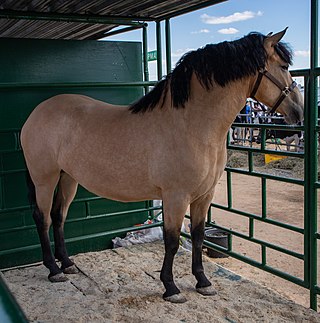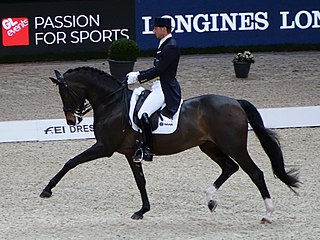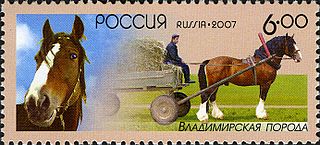Related Research Articles

The Tersk or Tersky is a Russian breed of light riding horse of Arab type. It was bred at the Tersk Stud in Stavropol Krai in the North Caucasus between about 1925 and 1940.

The Brandenburger is a German breed of warmblood sport horse from the state of Brandenburg in north-eastern Germany. From the 1960s – when Brandenburg was in East Germany – it was included in the stud-book of the Edles Warmblut or 'light warmblood'. Following the re-unification of Germany it again had its own stud-book. In 2003 it was included in the stud-book of the Deutsches Reitpferd, which also included the Sachsen-Anhaltiner Warmblut, the Sächsisches Warmblut and the Thüringer Warmblut; the Bavarian Warmblood, the Württemberger and the Zweibrücker were added to it in 2014.

The Ukrainian Riding Horse or Ukrainian Saddle Horse is a modern Ukrainian breed of warmblood sport horse. Breeding began in the years after the Second World War at the stud farm of Dnipropetrovsk in central Ukraine – at that time in the USSR – and later expanded to three other state stud farms. It derives from cross-breeding of Hanoverian, Thoroughbred and Trakehner stallions with local mares or with Hungarian Furioso, Gidran Arab or Nonius mares. It incorporates the last bloodlines of the extinct Orlov-Rostopchin or Russian Saddle Horse. It was bred to compete in show jumping, three-day eventing and dressage, but is also suitable as a general riding horse.

The Belarus Harness Horse, Belarusian: Беларускі запражны конь, romanized: Bielaruski zapražny koń, is a Belarusian breed of draught horse. It was bred for use in agriculture, and is also used to produce mare's milk and horsemeat.

The Knabstrupper or Knabstrup is a Danish breed of warmblood horse. It is principally a riding horse, but is also used as a harness horse and as a circus animal. It is broadly similar to the Frederiksborger, but often has a spotted coat. In the past, injudicious breeding for this characteristic alone compromised its constitution and conformation. In the years after the Second World War the mechanisation of agriculture led to a sharp fall in numbers, and by the 1960s no more than 100 of the horses remained. In the twenty-first century it is an endangered breed, with a world-wide population estimated at little over 2000.

The Czech Warmblood, Czech: Český Teplokrevník, is a modern Czech breed of warmblood sport horse.

The Lundy Pony is a British breed of pony bred on Lundy Island in the twentieth century.

The Swedish Warmblood is a Swedish breed of warmblood horse. It was originally bred as a cavalry horse at the Strömsholm, Ottenby and Flyinge studs. In the twentieth century it became a general-purpose riding and sport horse. It performs well in dressage, show-jumping and three-day eventing, and also as a harness horse.

The Brazilian Sport Horse or Brasileiro de hipismo is a modern Brazilian breed of warmblood horse. It was bred as a sport riding horse for competitive equestrian sports, particularly show jumping, dressage and three-day eventing.

The Latvian Horse is a purpose-bred warmblood horse breed from Latvia. Breeding began in Latvia in the early twentieth century, and a herd book was established in 1927. The breed was officially recognised in 1952. There are two types, sometimes called the Latvian Harness Horse and the Latvian Riding Horse. The harness type was predominant until about 1960, when demand for sport horses increased and more of the saddle type were bred.

The Vladimir Heavy Draft is a Russian breed of heavy draught horse. It was bred in the early twentieth century in farms and collectives in Ivanovo Oblast and Vladimir Oblast, to the east of Moscow. The most important influence on the development of the breed was from three Clydesdale stallions foaled between 1910 and 1923. The Vladimir was officially recognised in 1946.

The Gelderlander is a Dutch breed of warmblood horse. It was bred in the province of Gelderland in the Netherlands as a carriage horse capable also of farm work. It declined in popularity in the mid-twentieth century. In 1965 it was one of the foundation breeds of the Dutch Warmblood or KWPN, the other being the heavier Groninger horse from the north. It is registered in a division of the Royal Dutch Warmblood Horse Studbook, which also has divisions for the Dutch Warmblood and for the Dutch Harness Horse.

The North Swedish Horse or Swedish: Nordsvensk Brukshäst is a Swedish breed of small heavy horse. It is closely related to the similar Dølehest breed of Norway. It was traditionally used for forestry and agricultural work. Lighter lines are bred for harness racing, and are registered in the stud-book of the Svensk Kallblodstravare.
The Tawleed is a Sudanese breed of sport horse. It derives from the Sudanese Country-Bred through cross-breeding with imported blood horses, principally of Thoroughbred stock. It is found mainly in the Khartoum region of Sudan.

The German Riding Pony or Deutsches Reitpony is a modern German breed of pony or small horse of warmblood type. It is a composite of several horse or pony breeds including the Anglo-Arab, the Arab, the Connemara, the Dülmener, the New Forest Pony and the Welsh Pony. These were selectively bred with the aim of developing a small athletic riding horse with the qualities of the principal German warmbloods. Heights are in the range 137–147 cm or 141–148 cm. It constitutes about 5.7% of the horse population of Germany.

The Rhinelander, or Rheinisches Reitpferd, is a German warmblood breed of sport horse. It is traditionally bred at the Warendorf State Stud, which it shares with the Westphalian, and is bred to the same standard as the Westphalian and other German warmbloods, such as the Bavarian Warmblood, Mecklenburger, Brandenburger, and Württemberger.
Western Sudan Pony is an exonym for a Sudanese breed or group of breeds or ecotypes of small horse or pony. These are distributed principally in southern Darfur and south-western Kordofan, extending into southern Chad, and are known generically as Gharbaui ("western") or by a variety of regional names including Darfur Pony and Kordofani.

The Silesian Warmblood is a Polish breed of warmblood horse. It originates in the historic region of Silesia in south-western Poland and is the heaviest of the Polish warmblood breeds. It has been influenced mainly by the Oldenburger, and to some extent also by the East Friesian, the Hanoverian and the Thoroughbred.

The Polish Half-bred or Polish Noble Half-bred, Polish: Polski koń szlachetny półkrwi, is a modern Polish breed of warmblood sport horse. Breeding began in the 1960s. Mares of the traditional Polish Malopolski, Wielkopolski and Silesian Warmblood sport horse breeds were crossed with stallions of Western European breeds of established competitive ability. It was bred for competition in dressage, showjumping and eventing, but may also be used for recreational riding or amateur sports. It is one of four warmblood sport horses in Poland.
The Sudanese Country-Bred is a Sudanese breed of light riding horse. It was bred in the twentieth century by cross-breeding local mares of Barb type with imported Arab or Thoroughbred stallions.
References
- ↑ Barbara Rischkowsky, Dafydd Pilling (editors) (2007). List of breeds documented in the Global Databank for Animal Genetic Resources, annex to The State of the World's Animal Genetic Resources for Food and Agriculture. Rome: Commission on Genetic Resources for Food and Agriculture, Food and Agriculture Organization of the United Nations. ISBN 9789251057629. Archived 23 June 2020.
- 1 2 3 Breed data sheet: Vlaamperd / South Africa (Horse). Domestic Animal Diversity Information System of the Food and Agriculture Organization of the United Nations. Accessed August 2021.
- 1 2 3 4 5 6 Vlaamperde in Suid Afrika (in Afrikaans). Suid Afrikaanse Vlaamperdtelersgenootskap. Archived 25 November 2023.
- 1 2 3 4 Valerie Porter, Lawrence Alderson, Stephen J.G. Hall, D. Phillip Sponenberg (2016). Mason's World Encyclopedia of Livestock Breeds and Breeding (sixth edition). Wallingford: CABI. ISBN 9781780647944.
- 1 2 3 4 5 Élise Rousseau, Yann Le Bris, Teresa Lavender Fagan (2017). Horses of the World. Princeton: Princeton University Press. ISBN 9780691167206.
- ↑ [Department of Agriculture] (2006). South African Country Report on Farm Animal Resources; annex to: The State of the World's Animal Genetic Resources for Food and Agriculture. Rome: Food and Agriculture Organization of the United Nations. ISBN 9789251057629. Archived 1 September 2021.
- ↑ Southern African Horse Breeds. The Horse Society of Gauteng, Northern, Northwest and Mpumalanga. Archived 25 June 2005.
- ↑ [s.n.] (4 March 2020). AskHQ: The Vlaamperd. HQ Magazine. Archived 7 May 2023. [ unreliable source? ]